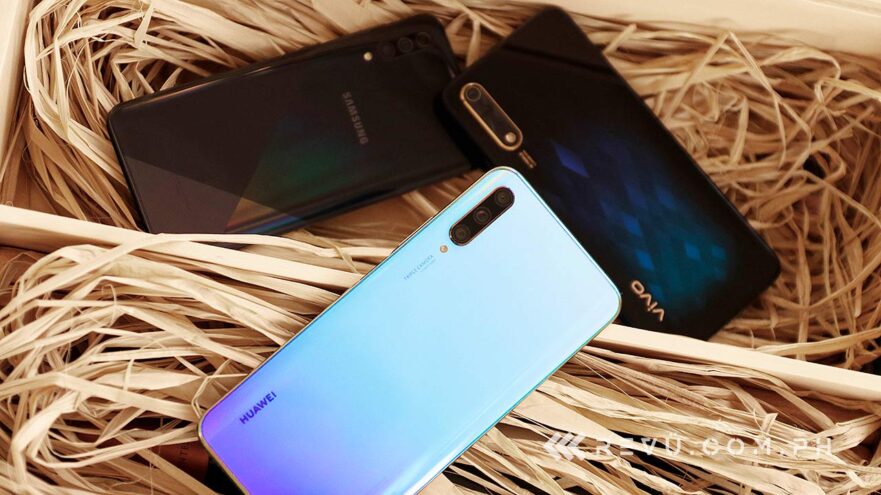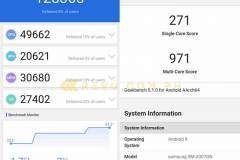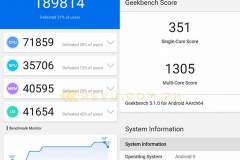It’s a battle royale between three outstanding midrange smartphones. Which one delivers the best overall value for your money?
On one corner stands the recently launched Huawei Y9s sporting a sizable all-screen front and a selfie camera that can hide behind the display. And on another corner, the Samsung Galaxy A30s offers an attractive feature set at a reasonably low price. Then there’s the Vivo S1, also a compelling option among budget-conscious consumers.
In the Philippines where it’s already available nationwide, the Y9s will run you P13,990 (around $275), while the A30s and S1 are priced at P12,990 and P12,999 ($256), respectively. All three devices are priced close enough, but can still bring different benefits to users with different needs and priorities. How do you decide which phone to buy then? Read this comparison to help you make a decision.
Hardware
In terms of looks and aesthetics, it’s the Huawei Y9s that comes out on top, with its full-screen design with no notch or cutout on the screen for the selfie camera. Huawei’s Breathing Crystal variant stands out in particular, because of its distinguished pearlescent finish that morphs between blue and purple depending on the light.
Both the Samsung Galaxy A30s and Vivo S1 have a waterdrop notch at the top bezel that, in addition to looking outdated, can get in the way of an immersive viewing experience. And while these phones come in different rear designs and colors, neither one looks more attractive and elegant than the Huawei. Though the Y9s is a little more expensive piece of hardware, it definitely shows on the exterior of the handset.
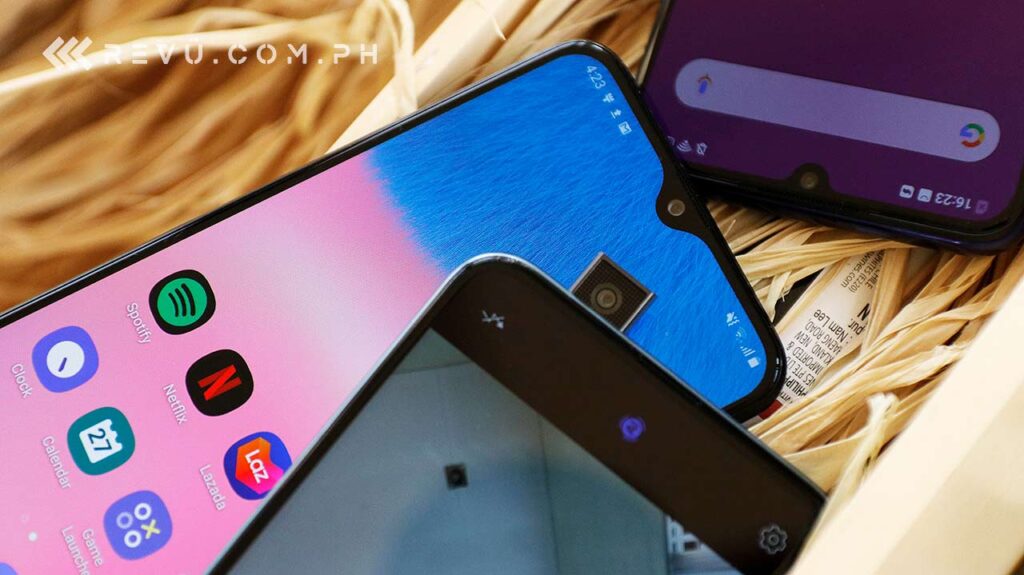
The Samsung Galaxy A30s and Vivo S1 have a waterdrop notch at the top while the Huawei Y9s comes with a full-screen design with no notch or cutout on the screen for the selfie camera
All three phones feature a plastic build with rounded edges that’s found on most current devices, but only the Galaxy A30s feels plasticky and cheap among the bunch. The build quality isn’t as good as it is on the competition. It’s also the lightest of all three.
The Huawei Y9s has the best build of the group — solid and exudes high quality for the price. It also has the most heft, in large part because of the pop-up camera mechanism hidden within its frame. Additionally, the Y9s feels the best in the hand, while the Vivo S1’s flat rear panel doesn’t lend a comfortable feel when held.
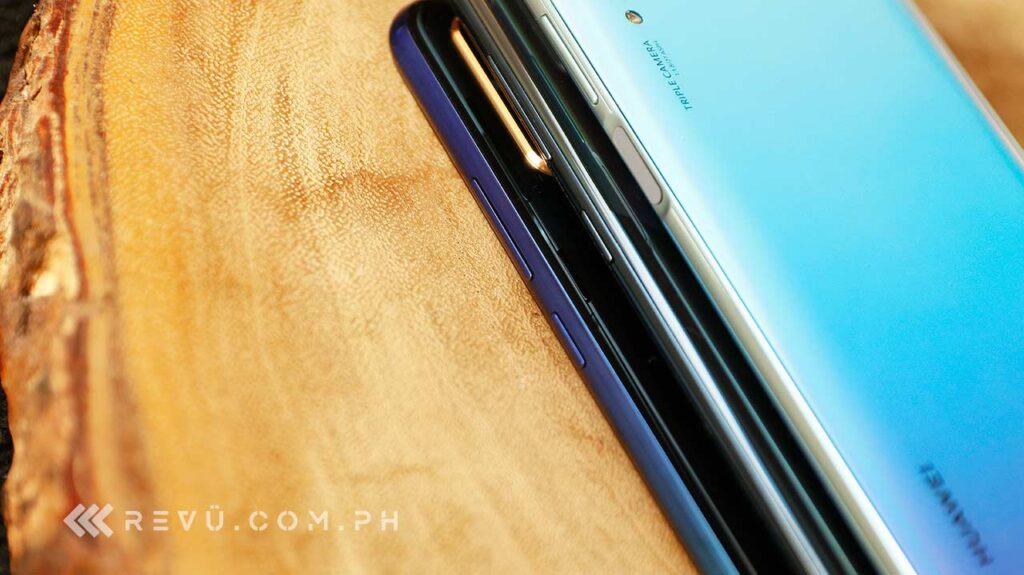
The Huawei Y9s has a side-mounted fingerprint scanner built into the power key on the right side, whereas the Samsung Galaxy A30s and Vivo S1 have an integrated biometric sensor in the screen
The Y9s includes a side-mounted fingerprint scanner built into the power key on the right side, whereas the A30s and S1 have an integrated biometric sensor in the screen. The fingerprint unlock on the Y9s is fast and reliable, and the scanner is located in a convenient position for you to rest your thumb or index finger. Talking about other hardware features, the S1 has a separate button along the left edge for quickly launching Google Assistant.
The Huawei and Samsung phones are equipped with USB-C, while the Vivo uses a dated microUSB port for charging and file transfers. Despite that, the S1 supports up to 18-watt fast charging and takes the least time to juice up compared with the Y9s and A30s, which max out at 10 and 15 watts, respectively.
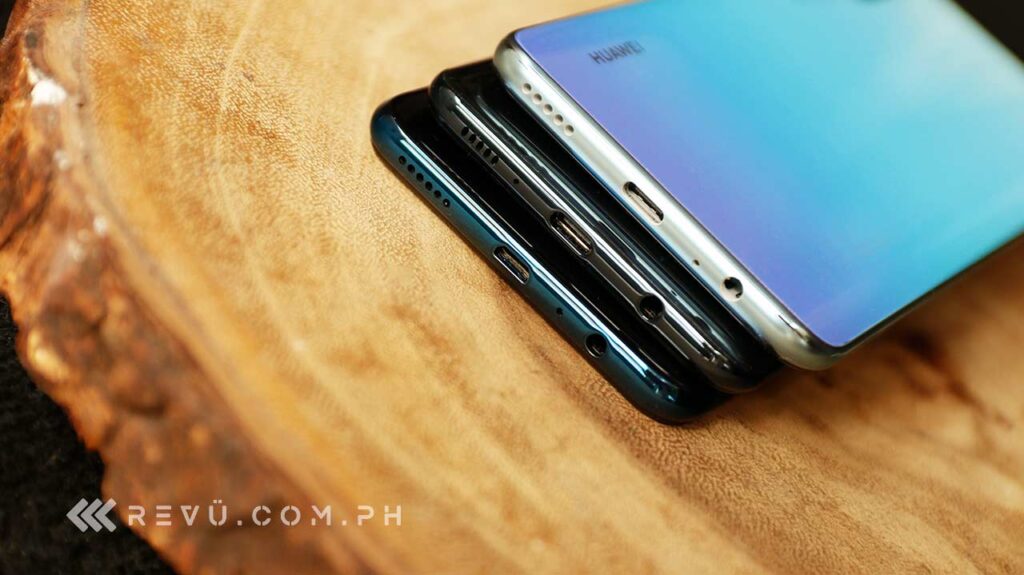
The Huawei and Samsung phones are equipped with USB-C, while the Vivo uses a microUSB port
All three devices have a headphone jack and a mono speaker at the bottom. The speaker on the Y9s sounds the best to our ears, but your mileage may vary depending on your taste and the genres of music you like to listen to.
Screen
In the display department, the Huawei arrives with a 6.59-inch LCD that runs a resolution of 2,340 x 1,080 pixels. The screen-to-body ratio is 91% — one of the highest we’ve seen on a midranger. That’s impressive. A higher screen-to-body ratio means more space for your content to be displayed without making the body itself uncomfortably big for you to hold.
The Samsung Galaxy A30s and Vivo S1 sport smaller screens — 6.4 and 6.38 inches, respectively — but they use AMOLED technology, which typically delivers a brighter and more vibrant picture. It’s also important to note that the Vivo handset includes the always-on display function that most AMOLEDs enjoy, but the A30s, for some reason, lacks it.
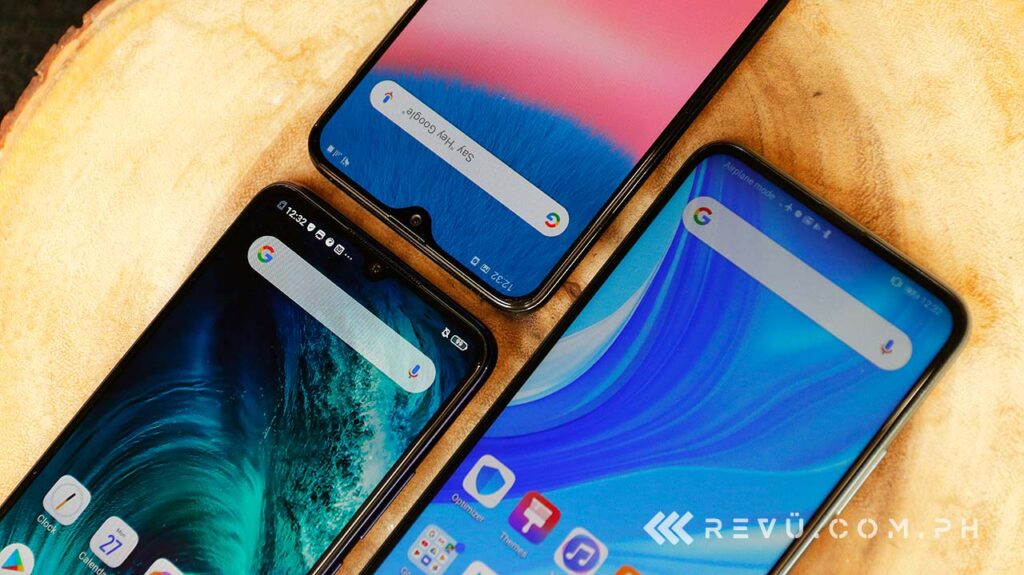
The Huawei Y9s arrives with a 6.59-inch LCD that runs a 91% screen-to-body ratio. The Samsung Galaxy A30s and Vivo S1, on the other hand, sport smaller displays — 6.4 and 6.38 inches, respectively
When it comes to screen performance, the S1 delivers the most striking picture and works best outdoors under direct sunlight.
The one on the Huawei Y9s is decent as well, and the colors look natural and pleasing to the eye. A bigger, no-notch display likewise means a larger keyboard, more content on a single page, and more real estate for gaming and watching videos. In short, a full-view screen maximizes your viewing experience.
Meanwhile, the Samsung phone has the worst-performing display of the group. We also found it to be too warm by default, so you may want to adjust the color temperature in the Settings menu and move the slider to a cooler setting.
Camera
As for the camera specs, Huawei has equipped the Y9s with a 48-megapixel primary sensor. The high-resolution camera is joined by an 8-megapixel ultra-wide shooter and a 2-megapixel depth sensor that adds bokeh to portrait-style shots.
The main camera is capable of well-exposed images with vivid color representation and high dynamic range. It takes 12-megapixel pictures by default, using four-in-one pixel binning to get the best results from the 48-megapixel sensor. There is an option that allows the camera to natively capture full-resolution shots, so even if, say, you crop half off an image, you’ll still get more fine details.
Take note that the Huawei Y9s is the only one among the three that has a dedicated Night mode in the camera app, although it’s limited to the main sensor. Low-light shots look awesome considering the price.
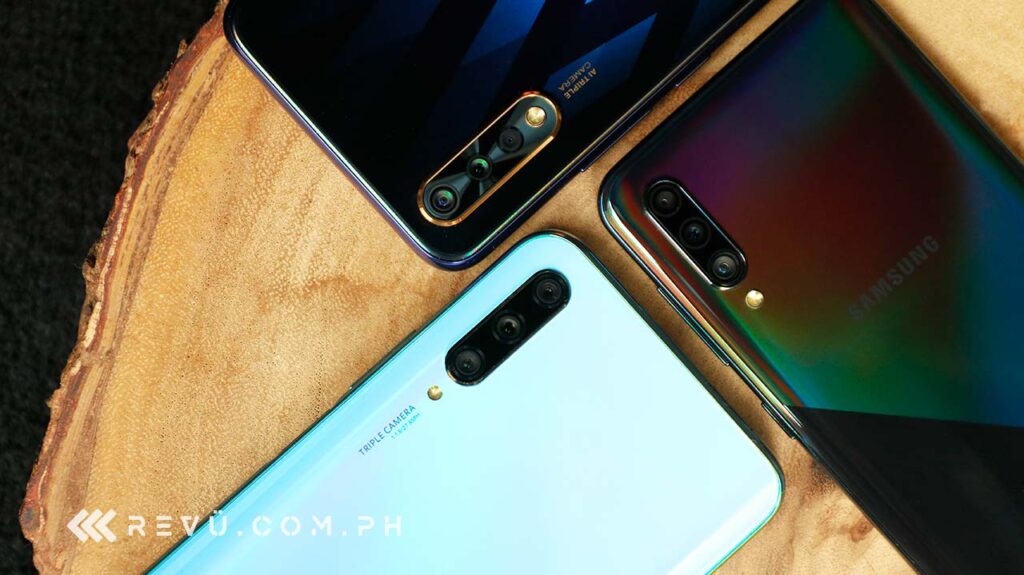
The Y9s is the only one among the three that has a dedicated Night mode in the camera app
The Samsung Galaxy A30s sees a 25-megapixel main camera alongside an 8-megapixel wide-angle shooter and a 5-megapixel depth sensor. Like the Y9s and A30s, the Vivo S1 sports a triple-camera setup on the back, too. The primary sensor is 16 megapixels, while the secondary cameras for landscapes and bokeh are rated at 8 and 5 megapixels, respectively.
The primary sensors of the A30s and S1 perform well during the day, but the lack of a night-shooting mode certainly hurts their output when lighting isn’t ideal. Another thing you may not like is the noticeable fish-eye effect or lens distortion on the edges of wide-angle photos. You don’t get the same extra-wide field of view on the Y9s, so the degree of distortion isn’t distracting.
Huawei Y9s vs Samsung Galaxy A30s vs Vivo S1 (in this order): Comparison of sample pictures
First shot is that of the Huawei Y9s with Night mode enabled
Distortion is most visible in the photo captured by the Samsung Galaxy A30s
To summarize: When it comes to rear cameras, Night mode and a sufficient ultra-wide feature give the Huawei Y9s an edge over the other two smartphones.
Quite surprisingly, Huawei has opted for a wide focal length for selfies — wider than those on the the A30s and S1. Both the Y9s and A30s are fitted with 16-megapixel front-facing cameras; the S1 rocks a higher-resolution 32-megapixel camera. As you might expect, the Vivo takes better selfies with realistic skin tones and pleasing details. Shooting against the light, the front-facer’s HDR mode yields perfectly usable results.
Huawei Y9s vs Samsung Galaxy A30s vs Vivo S1 (in this order): Comparison of selfies
Performance
All three devices are powered by an octa-core chipset, coupled with an ample amount of RAM and storage. The Y9s packs Huawei’s HiSilicon Kirin 710F, which is the same chip used in the Y9 Prime 2019 and many other midrange handsets. It’s fabricated on a 12nm process. The A30s incorporates Samsung’s own 14nm Exynos 7904 chip, and the S1 has a 12nm MediaTek Helio P65. A smaller manufacturing process — 12nm, in this case — allows for better power efficiency and longer battery life.
Both the Huawei Y9s and Vivo S1 ship with 6GB RAM and 128GB of internal memory, whereas the Samsung Galaxy A30s sold on the local market is paired with 4GB RAM and 64GB storage. All three have expandable storage via a microSD card slot, so running out of space won’t be an issue on any of the phones. The added RAM on the Y9s and S1, though, could be helpful for multitasking and is good to have for futureproofing.
When it comes to playing demanding mobile games, the Samsung Galaxy A30s is noticeably less powerful than the Huawei Y9s and Vivo S1. It can’t run Mobile Legends: Bang Bang at the Ultra graphics preset
In terms of daily tasks such as navigating the home screen, opening native apps, and using Facebook, the three handsets perform pretty much the same. However, when it comes to playing demanding mobile games, the Samsung is noticeably less powerful than the Y9s and S1. It can’t run Mobile Legends: Bang Bang at the Ultra graphics preset. On top of that, our A30s unit got the lowest benchmark scores on Antutu and Geekbench.
The Huawei Y9s, on the other hand, achieved the highest scores in the same tests. It also has GPU Turbo 3.0 baked into the software for smoother gameplay. This solution is implemented at the software level and controls how the GPU handles graphics, allowing it to anticipate workload and allocate resources for it.
Huawei Y9s vs Samsung Galaxy A30s vs Vivo S1: Antutu and Geekbench benchmark scores
GPU Turbo will tell the graphics API which frames to render next and whether it needs to render new ones or use those that have already been rendered. It can help the phone conserve battery because it will know when to use more power (and conversely, when the load is lighter, slow down performance). The software feature currently supports more than 85 of the most popular Android games.
As for battery capacity, the Y9s and A30s have a 4,000mAh cell each. The S1 packs the biggest battery at 4,500mAh. The battery life on all three devices is good enough to get you through an entire day. The Y9s is especially commendable when idle due to Huawei’s aggressive battery management and the Kirin 710F’s power efficiency.
Final thoughts
The Huawei Y9s, Samsung Galaxy A30s, and Vivo S1 are all great choices if you’re in the market for reasonably priced smartphone with good specs across the board.
The S1’s specs sheet, with a fingerprint-sensing AMOLED screen, a 32-megapixel front camera, and a 4,500mAh battery, reads impressively.
If you go beyond the numbers on paper, it’s the Y9s that can turn heads with a nicely constructed polycarbonate body that looks and feels as upscale as it gets in the segment. Its 6.59-inch LCD display that stretches to all four sides of the device is the largest of the bunch. Plus the 48-megapixel AI triple camera is commendable, especially with the included Night mode that the Vivo and Samsung lack.
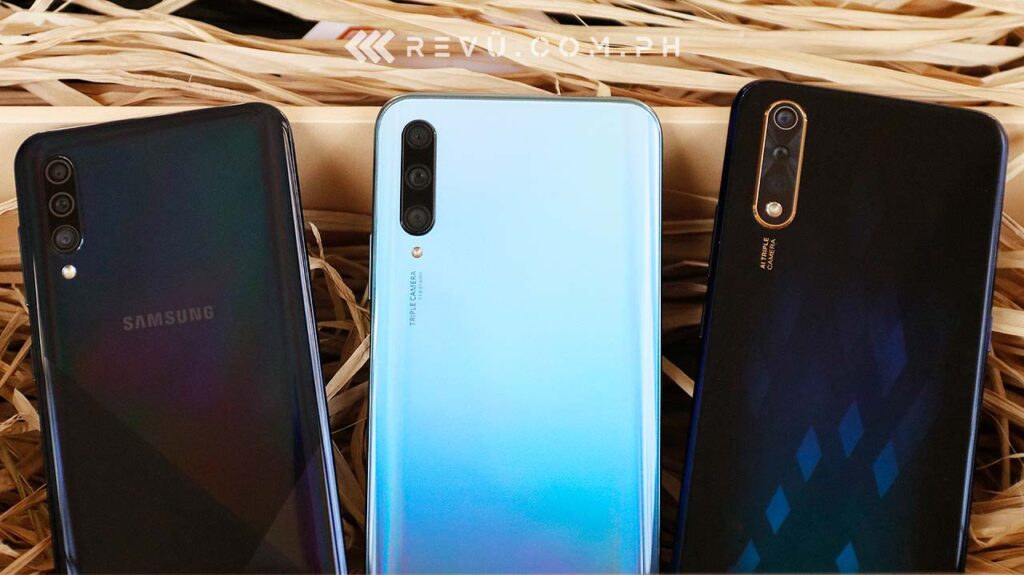
And the winner is…
The clear third-placer in this comparison, though, is the A30s. Unfortunately for Samsung fans, the midrange Galaxy doesn’t offer a ton of value for the price, especially since it isn’t substantially cheaper than the Y9s, and costs about the same as the Vivo phone. The Exynos 7904 doesn’t compare well against Huawei’s Kirin 710F and the MediaTek Helio P65. It also has the least amount of RAM and native storage, while the GPU isn’t powerful enough for hardcore gaming.
Ahead of the Samsung, it’s a toss-up between the Y9s and S1. Looking for a more premium design, an all-screen front for a more immersive viewing experience, and better photography and low-light performance? Get the Huawei Y9s. If you’d rather have an AMOLED display, longer battery life, and more detailed selfies, the Vivo S1 is the way to go. Either one will be worth a purchase.
Share this Post

